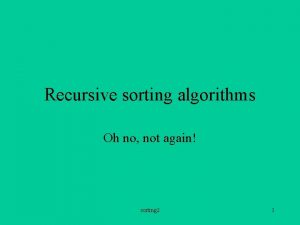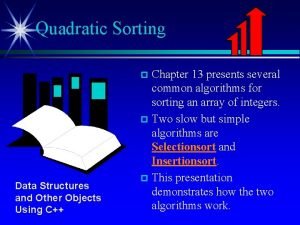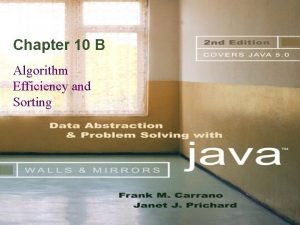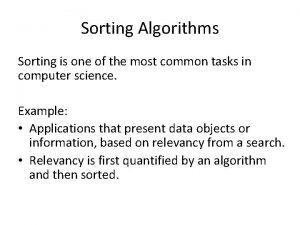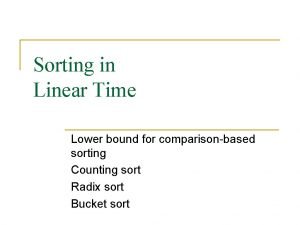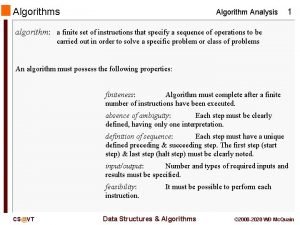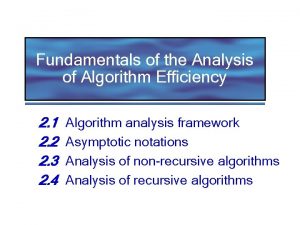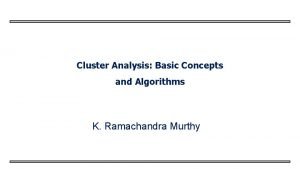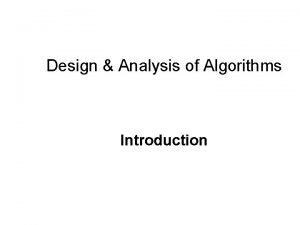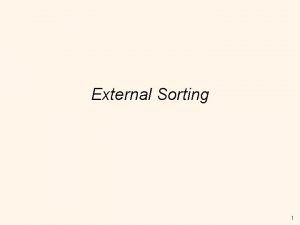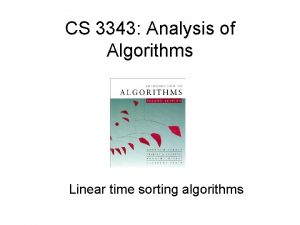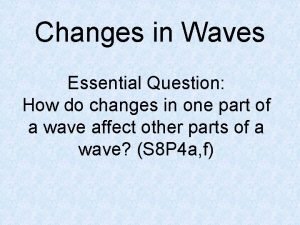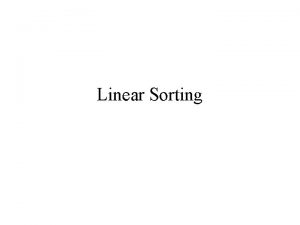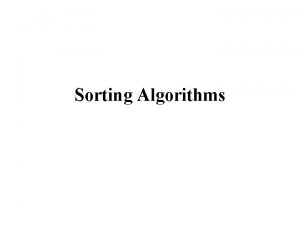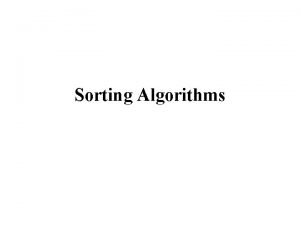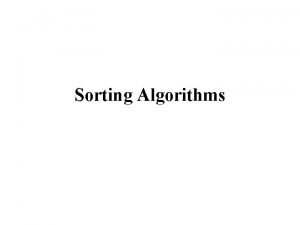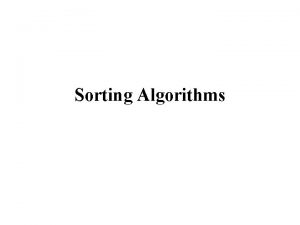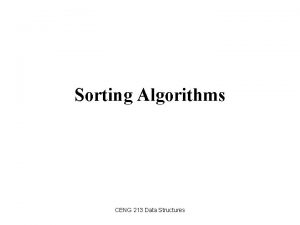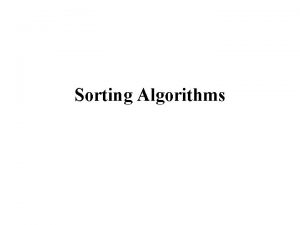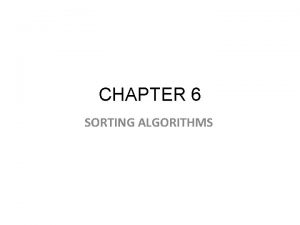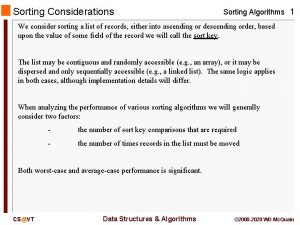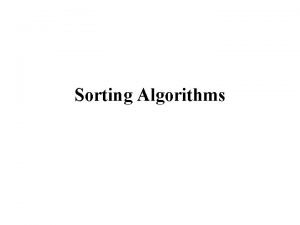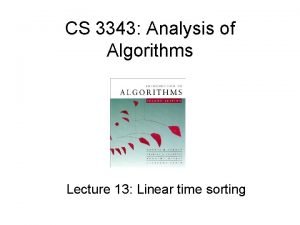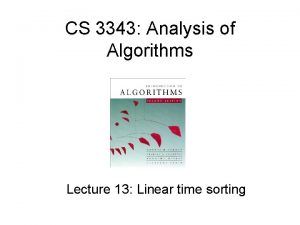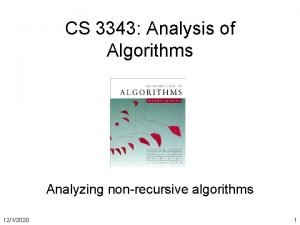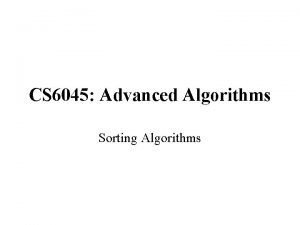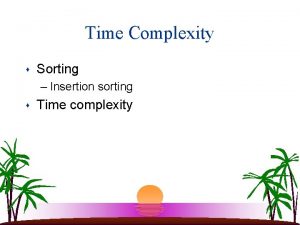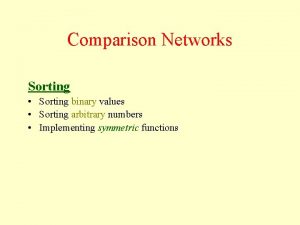CS 3343 Analysis of Algorithms Linear time sorting








![Counting sort • Input: A[1. . n], where A[ j]Î{1, 2, …, k}. • Counting sort • Input: A[1. . n], where A[ j]Î{1, 2, …, k}. •](https://slidetodoc.com/presentation_image/5418acb8c6b4af5a009163a67bb1f6a0/image-9.jpg)


![Counting sort 1. for i 1 to k Initialize do C[i] 0 Count 2. Counting sort 1. for i 1 to k Initialize do C[i] 0 Count 2.](https://slidetodoc.com/presentation_image/5418acb8c6b4af5a009163a67bb1f6a0/image-12.jpg)




















![Analysis (k) (n) (n + k) 1. for i 1 to k do C[i] Analysis (k) (n) (n + k) 1. for i 1 to k do C[i]](https://slidetodoc.com/presentation_image/5418acb8c6b4af5a009163a67bb1f6a0/image-33.jpg)
























- Slides: 57

CS 3343: Analysis of Algorithms Linear time sorting algorithms

More about sorting • How many sorting algorithms do you know? • What are their time complexity? • What’s common about them? • Can we do better than Θ(n log n)? • Yes and no

Outline • More about sorting – Theoretical lower-bound – Linear-time sorting algorithms – Stability of sorting

Theoretical lower-bound • Comparison sort: determines the relative order of two elements only by comparison – What else can you do … – Text book Ch 8. 1 shows that theoretical lower-bound for any comparison-based sorting algorithm is Θ(n log n)

Lower-bound of comparison-based sort • Assume an array A with 3 distinct elements, a 1, a 2, and a 3 • Use insertion sort 1 < 2? no yes • # comparisons? 2 < 3? 1<3? • A = [9 6 5] no no yes • A = [5 6 9] (1, 2, 3) 1 < 3? (2, 1, 3) 2 < 3? • A=… yes no no (1, 3, 2) (3, 1, 2) (2, 3, 1) (3, 2, 1)

Lower-bound of comparison-based sort • Assume all elements are distinct, each comparison has two possible outcomes: ai < aj or ai > aj • Based on the outcome, change the relative order of some elements • Output is a permutation of the input • A correct sorting algorithm can handle any arbitrary input • n! possible permutations • Therefore, at least log(n!) = Θ(nlogn) comparisons in the worst case A ai < a j ai > a j A’ A’’ Θ(n!) log(n!)

Sorting in linear time • Is there a problem with theory? • No. We are going to sort without doing comparison • How is that possible? • Key: knowledge about the data – Example: Almost sorted? All distinct? Many identical ones? Uniformly distributed? – The more you know about your data, the more likely you can have a better algorithm

Counting sort • Knowledge: the numbers fall in a small range • Example 1: sort the final exam score of a large class – – 1000 students Maximum score: 100 Minimum score: 0 Scores are integers • Example 2: sort students according to the first letter of their last name – Number of students: many – Number of letters: 26
![Counting sort Input A1 n where A jÎ1 2 k Counting sort • Input: A[1. . n], where A[ j]Î{1, 2, …, k}. •](https://slidetodoc.com/presentation_image/5418acb8c6b4af5a009163a67bb1f6a0/image-9.jpg)
Counting sort • Input: A[1. . n], where A[ j]Î{1, 2, …, k}. • Output: B[1. . n], sorted. • Auxiliary storage: C[1. . k]. • Not an in-place sorting algorithm • Requires (n+k) additional storage besides the original array

Intuition • • • S 1: 100 S 2: 90 S 3: 85 S 4: 100 S 5: 90 … 0 85 90 100 S 3 S 2 S 1 S 5 S 4 … S 3 … S 2, S 5, …, S 1, S 4

Intuition 75 85 90 100 1 1 2 2 50 students with score ≤ 75 What is the rank (lowest to highest) for a student with score = 75? 50 200 students with score ≤ 90 What is the rank for a student with score = 90? 200 or 199
![Counting sort 1 for i 1 to k Initialize do Ci 0 Count 2 Counting sort 1. for i 1 to k Initialize do C[i] 0 Count 2.](https://slidetodoc.com/presentation_image/5418acb8c6b4af5a009163a67bb1f6a0/image-12.jpg)
Counting sort 1. for i 1 to k Initialize do C[i] 0 Count 2. for j 1 to n do C[A[ j]] + 1 ⊳ C[i] = |{key = i}| Compute running sum 3. for i 2 to k do C[i] + C[i– 1] ⊳ C[i] = |{key £ i}| 4. for j n downto 1 Re-arrange do B[C[A[ j]]] A[ j] C[A[ j]] – 1

Counting-sort example A: B: 1 2 3 4 5 4 1 3 4 3 1 C: 2 3 4

Loop 1: initialization A: 1 2 3 4 5 4 1 3 4 3 B: 1. for i 1 to k do C[i] 0 C: 1 2 3 4 0 0

Loop 2: count A: 1 2 3 4 5 4 1 3 4 3 C: 1 2 3 4 0 0 0 1 B: 2. for j 1 to n do C[A[ j]] + 1 ⊳ C[i] = |{key = i}|

Loop 2: count A: 1 2 3 4 5 4 1 3 4 3 C: 1 2 3 4 1 0 0 1 B: 2. for j 1 to n do C[A[ j]] + 1 ⊳ C[i] = |{key = i}|

Loop 2: count A: 1 2 3 4 5 4 1 3 4 3 C: 1 2 3 4 1 0 1 1 B: 2. for j 1 to n do C[A[ j]] + 1 ⊳ C[i] = |{key = i}|

Loop 2: count A: 1 2 3 4 5 4 1 3 4 3 C: 1 2 3 4 1 0 1 2 B: 2. for j 1 to n do C[A[ j]] + 1 ⊳ C[i] = |{key = i}|

Loop 2: count A: 1 2 3 4 5 4 1 3 4 3 C: 1 2 3 4 1 0 2 2 B: 2. for j 1 to n do C[A[ j]] + 1 ⊳ C[i] = |{key = i}|

Loop 3: compute running sum A: 1 2 3 4 5 4 1 3 4 3 B: 3. for i 2 to k do C[i] + C[i– 1] 1 2 3 4 C: 1 0 2 2 C': 1 1 2 2 ⊳ C[i] = |{key £ i}|

Loop 3: compute running sum A: 1 2 3 4 5 4 1 3 4 3 B: 3. for i 2 to k do C[i] + C[i– 1] 1 2 3 4 C: 1 0 2 2 C': 1 1 3 2 ⊳ C[i] = |{key £ i}|

Loop 3: compute running sum A: 1 2 3 4 5 4 1 3 4 3 B: 3. for i 2 to k do C[i] + C[i– 1] 1 2 3 4 C: 1 0 2 2 C': 1 1 3 5 ⊳ C[i] = |{key £ i}|

Loop 4: re-arrange A: B: 1 2 3 4 5 4 1 3 4 3 3 4. for j n downto 1 1 2 3 4 C: 1 1 3 5 C': 1 1 3 5 do B[C[A[ j]]] A[ j] C[A[ j]] – 1

Loop 4: re-arrange A: B: 1 2 3 4 5 4 1 3 4 3 3 4. for j n downto 1 1 2 3 4 C: 1 1 3 5 C': 1 1 2 5 do B[C[A[ j]]] A[ j] C[A[ j]] – 1

Loop 4: re-arrange A: B: 1 2 3 4 5 4 1 3 4 3 4. for j n downto 1 1 2 3 4 C: 1 1 2 5 C': 1 1 2 5 do B[C[A[ j]]] A[ j] C[A[ j]] – 1

Loop 4: re-arrange A: B: 1 2 3 4 5 4 1 3 4 3 4. for j n downto 1 1 2 3 4 C: 1 1 2 5 C': 1 1 2 4 do B[C[A[ j]]] A[ j] C[A[ j]] – 1

Loop 4: re-arrange A: B: 1 2 3 4 5 4 1 3 4 3 3 3 4 4. for j n downto 1 1 2 3 4 C: 1 1 2 4 C': 1 1 2 4 do B[C[A[ j]]] A[ j] C[A[ j]] – 1

Loop 4: re-arrange A: B: 1 2 3 4 5 4 1 3 4 3 3 3 4 4. for j n downto 1 1 2 3 4 C: 1 1 2 4 C': 1 1 1 4 do B[C[A[ j]]] A[ j] C[A[ j]] – 1

Loop 4: re-arrange 1 2 3 4 5 A: 4 1 3 4 3 B: 1 3 3 4 4. for j n downto 1 1 2 3 4 C: 1 1 1 4 C': 1 1 1 4 do B[C[A[ j]]] A[ j] C[A[ j]] – 1

Loop 4: re-arrange 1 2 3 4 5 A: 4 1 3 4 3 B: 1 3 3 4 4. for j n downto 1 1 2 3 4 C: 1 1 1 4 C': 0 1 1 4 do B[C[A[ j]]] A[ j] C[A[ j]] – 1

Loop 4: re-arrange 1 2 3 4 5 A: 4 1 3 4 3 B: 1 3 3 4 4 4. for j n downto 1 1 2 3 4 C: 0 1 1 4 C': 0 1 1 4 do B[C[A[ j]]] A[ j] C[A[ j]] – 1

Loop 4: re-arrange 1 2 3 4 5 A: 4 1 3 4 3 B: 1 3 3 4 4 4. for j n downto 1 1 2 3 4 C: 0 1 1 4 C': 0 1 1 3 do B[C[A[ j]]] A[ j] C[A[ j]] – 1
![Analysis k n n k 1 for i 1 to k do Ci Analysis (k) (n) (n + k) 1. for i 1 to k do C[i]](https://slidetodoc.com/presentation_image/5418acb8c6b4af5a009163a67bb1f6a0/image-33.jpg)
Analysis (k) (n) (n + k) 1. for i 1 to k do C[i] 0 2. for j 1 to n do C[A[ j]] + 1 3. for i 2 to k do C[i] + C[i– 1] 4. for j n downto 1 do B[C[A[ j]]] A[ j] C[A[ j]] – 1

Running time If k = O(n), then counting sort takes (n) time. • But, theoretical lower-bound sorting takes W(n log n) time! • Problem with theory? Answer: • Comparison sorting takes W(n log n) time. • Counting sort is not a comparison sort. • In fact, not a single comparison between elements occurs!

Stable sorting Counting sort is a stable sort: it preserves the input order among equal elements. A: 4 1 3 4 3 B: 1 3 3 4 4 Why this is important? What other algorithms have this property?

Task: sort students by alphabetical order of their addresses (state, city, street).

Task: sort students by alphabetical order of their addresses (state, city, street).

Task: sort students by alphabetical order of their addresses (state, city, street).

Task: sort students by alphabetical order of their addresses (state, city, street).

Task: sort students by alphabetical order of their addresses (state, city, street).

Task: sort students by alphabetical order of their addresses (state, city, street).

Task: sort students by alphabetical order of their addresses (state, city, street).

Task: sort students by alphabetical order of their addresses (state, city, street).

Task: sort students by alphabetical order of their addresses (state, city, street).

Task: sort students by alphabetical order of their addresses (state, city, street).

Task: sort students by alphabetical order of their addresses (state, city, street).

Task: sort students by alphabetical order of their addresses (state, city, street).

Task: sort students by alphabetical order of their addresses (state, city, street).

Stable sort • Most Θ(n^2) sorting algorithms are stable – Standard selection sort is not, but can be made so • Most Θ(n log n) sorting algorithms are not stable – Except merge sort • Generic way to make any sorting algorithm stable – Use two keys, the second key is the original index of the element – When two elements are equal, compare their second keys 5, 6, 5, 1, 2, 3, 2, 6 (5, 1), (6, 2), (5, 3), (1, 4), (2, 5), (3, 6), (2, 7), (6, 8) (5, 1) < (5, 3) (2, 5) < (2, 7)

How to sort very large numbers? 198099109123518183599 340199540380128115295 384700101594539614696 382408360201039258538 614386507628681328936 738148652090990369197 987084087096653020299 185664124421234516454 785392075747859131885 530995223593137397354 267057490443618111767 795293581914837377527 815501764221221110674 142522204403312937607 718098797338329180836 856504702326654684056 982119770959427525245 528076153239047050820 305445639847201611168 478334240651199238019 Those numbers are too large for the int type. They are represented as strings. One method: Use comparison-based sorting, but compare strings character by character. Change if (A[i] < A[j]) to if (compare(A[i], A[j]) < 0) Compare(s, t) for i = 1 to length(s) if (s[i] < t[i]) return -1; else if (s[i] > t[i]) return 1; return 0; What’s the cost to compare two strings, each with d characters? Θ(d) Total cost: Θ(d n log n)

Radix sort • Similar to sorting address books • Treat each digit as a key • Start from the least significant bit Most significant Least significant 198099109123518183599 340199540380128115295 384700101594539614696 382408360201039258538 614386507628681328936

Radix sort illustration • Use simpler examples: 7 7 0 6 4 2 9 1 1 4 3 6 0 0 3 1 0 4 4 5 8 1 3 3 1 6 3 8 6 3 1 6 7 1 2 8 4 8 2 0 5 6 1 4 5 6 1 3 5 3 6

Radix sort illustration • Sort the last digit: 2 1 0 7 4 0 1 0 4 9 3 3 1 6 0 7 6 3 4 1 1 7 5 3 3 8 6 1 4 8 0 1 1 2 2 3 3 4 4 5 5 5 6 6 6 8 8

Radix sort illustration • Sort the second digit: 4 0 1 0 2 0 4 9 7 7 0 1 3 6 1 1 3 3 4 4 5 6 6 6 7 8 8 2 3 6 6 0 1 4 5 2 8 4 1 5 6 3 5 8

Radix sort illustration • Sort the first digit: 0 0 1 1 1 2 3 3 4 4 6 6 7 7 9 1 1 3 5 1 6 7 3 6 8 1 3 6 8 4 4 3 3 6 1 4 6 1 3 0 5 5 2 4 6 8 2 8 5

Time complexity • Sort each of the d digits by counting sort • Total cost: d (n + k) – k = 10 – Total cost: Θ(dn) • Partition the d digits into groups of 3 – Total cost: (n+103)d/3 • We work with binaries rather than decimals – – – Partition d bits into groups of r bits Total cost: (n+2 r)d/r Choose r = log n Total cost: dn / log n Compare with dn log n • Catch: radix sort has a larger hidden constant factor

Space complexity • Calls counting sort • Therefore additional storage is needed • (n)
 Internal vs external sorting
Internal vs external sorting Clhelse
Clhelse Quadratic sorting algorithms
Quadratic sorting algorithms Efficiency of sorting algorithms
Efficiency of sorting algorithms Sorting algorithms in c
Sorting algorithms in c Big o functions
Big o functions 10 sorting algorithms
10 sorting algorithms Sorting algorithms with examples
Sorting algorithms with examples N
N Most common sorting algorithms
Most common sorting algorithms Introduction to sorting algorithms
Introduction to sorting algorithms Lower bound for comparison based sorting algorithms
Lower bound for comparison based sorting algorithms Undecidable problems and unreasonable time algorithms.
Undecidable problems and unreasonable time algorithms. How to find complexity of algorithm
How to find complexity of algorithm Undecidable problems and unreasonable time algorithms
Undecidable problems and unreasonable time algorithms 1001 design
1001 design An introduction to the analysis of algorithms
An introduction to the analysis of algorithms Analyze algorithm
Analyze algorithm Association analysis: basic concepts and algorithms
Association analysis: basic concepts and algorithms Output in algorithm
Output in algorithm Analysis of algorithms
Analysis of algorithms Analysis of algorithms
Analysis of algorithms Fundamentals of the analysis of algorithm efficiency
Fundamentals of the analysis of algorithm efficiency Cluster analysis basic concepts and algorithms
Cluster analysis basic concepts and algorithms Probabilistic analysis and randomized algorithms
Probabilistic analysis and randomized algorithms Design and analysis of algorithms introduction
Design and analysis of algorithms introduction Analysis of algorithms lecture notes
Analysis of algorithms lecture notes Cluster analysis basic concepts and algorithms
Cluster analysis basic concepts and algorithms Cjih
Cjih Goals of analysis of algorithms
Goals of analysis of algorithms Cluster analysis basic concepts and algorithms
Cluster analysis basic concepts and algorithms Binary search in design and analysis of algorithms
Binary search in design and analysis of algorithms Introduction to the design and analysis of algorithms
Introduction to the design and analysis of algorithms Competitive analysis algorithms
Competitive analysis algorithms Design and analysis of algorithms
Design and analysis of algorithms Design and analysis of algorithms
Design and analysis of algorithms Cluster analysis basic concepts and algorithms
Cluster analysis basic concepts and algorithms Comp 482
Comp 482 Start time, end time and elapsed time
Start time, end time and elapsed time Lego sorting robot
Lego sorting robot Tujuan pengurutan adalah
Tujuan pengurutan adalah Dn
Dn Evaporation for separating mixtures
Evaporation for separating mixtures How is chert formed
How is chert formed Sorting classifier
Sorting classifier Sorting grain size phi
Sorting grain size phi Sediment sorting
Sediment sorting Inplace sorting
Inplace sorting What horrible thought struck harry
What horrible thought struck harry Examples of external sorting
Examples of external sorting Stable sorting algorithm
Stable sorting algorithm Sorting circuit
Sorting circuit How to grade potatoes
How to grade potatoes Sorting quadrilaterals
Sorting quadrilaterals Changes in wave properties sorting activity
Changes in wave properties sorting activity Angles of quadrilaterals worksheet
Angles of quadrilaterals worksheet Pengertian searching dalam struktur data
Pengertian searching dalam struktur data Pengertian searching dalam struktur data
Pengertian searching dalam struktur data

